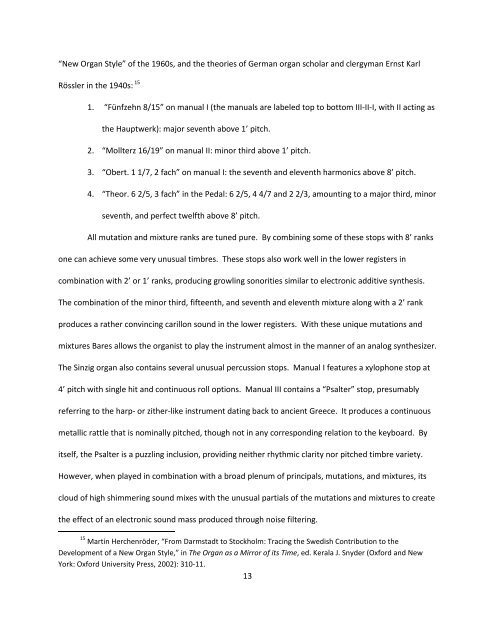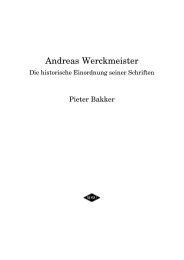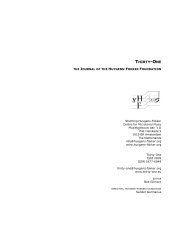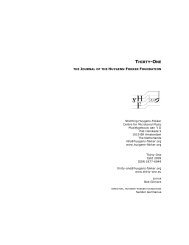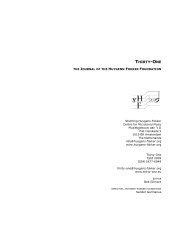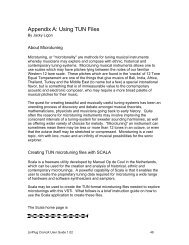Recent Organ Design Innovations and the 21st-century - Stichting ...
Recent Organ Design Innovations and the 21st-century - Stichting ...
Recent Organ Design Innovations and the 21st-century - Stichting ...
You also want an ePaper? Increase the reach of your titles
YUMPU automatically turns print PDFs into web optimized ePapers that Google loves.
“New <strong>Organ</strong> Style” of <strong>the</strong> 1960s, <strong>and</strong> <strong>the</strong> <strong>the</strong>ories of German organ scholar <strong>and</strong> clergyman Ernst Karl<br />
Rössler in <strong>the</strong> 1940s: 15<br />
1. “Fünfzehn 8/15” on manual I (<strong>the</strong> manuals are labeled top to bottom III-II-I, with II acting as<br />
<strong>the</strong> Hauptwerk): major seventh above 1’ pitch.<br />
2. “Mollterz 16/19” on manual II: minor third above 1’ pitch.<br />
3. “Obert. 1 1/7, 2 fach” on manual I: <strong>the</strong> seventh <strong>and</strong> eleventh harmonics above 8’ pitch.<br />
4. “Theor. 6 2/5, 3 fach” in <strong>the</strong> Pedal: 6 2/5, 4 4/7 <strong>and</strong> 2 2/3, amounting to a major third, minor<br />
seventh, <strong>and</strong> perfect twelfth above 8’ pitch.<br />
All mutation <strong>and</strong> mixture ranks are tuned pure. By combining some of <strong>the</strong>se stops with 8’ ranks<br />
one can achieve some very unusual timbres. These stops also work well in <strong>the</strong> lower registers in<br />
combination with 2’ or 1’ ranks, producing growling sonorities similar to electronic additive syn<strong>the</strong>sis.<br />
The combination of <strong>the</strong> minor third, fifteenth, <strong>and</strong> seventh <strong>and</strong> eleventh mixture along with a 2’ rank<br />
produces a ra<strong>the</strong>r convincing carillon sound in <strong>the</strong> lower registers. With <strong>the</strong>se unique mutations <strong>and</strong><br />
mixtures Bares allows <strong>the</strong> organist to play <strong>the</strong> instrument almost in <strong>the</strong> manner of an analog syn<strong>the</strong>sizer.<br />
The Sinzig organ also contains several unusual percussion stops. Manual I features a xylophone stop at<br />
4’ pitch with single hit <strong>and</strong> continuous roll options. Manual III contains a “Psalter” stop, presumably<br />
referring to <strong>the</strong> harp- or zi<strong>the</strong>r-like instrument dating back to ancient Greece. It produces a continuous<br />
metallic rattle that is nominally pitched, though not in any corresponding relation to <strong>the</strong> keyboard. By<br />
itself, <strong>the</strong> Psalter is a puzzling inclusion, providing nei<strong>the</strong>r rhythmic clarity nor pitched timbre variety.<br />
However, when played in combination with a broad plenum of principals, mutations, <strong>and</strong> mixtures, its<br />
cloud of high shimmering sound mixes with <strong>the</strong> unusual partials of <strong>the</strong> mutations <strong>and</strong> mixtures to create<br />
<strong>the</strong> effect of an electronic sound mass produced through noise filtering.<br />
15<br />
Martin Herchenröder, “From Darmstadt to Stockholm: Tracing <strong>the</strong> Swedish Contribution to <strong>the</strong><br />
Development of a New <strong>Organ</strong> Style,” in The <strong>Organ</strong> as a Mirror of its Time, ed. Kerala J. Snyder (Oxford <strong>and</strong> New<br />
York: Oxford University Press, 2002): 310-11.<br />
13


